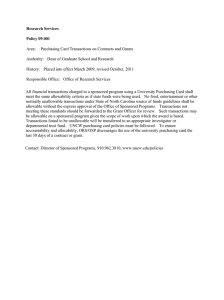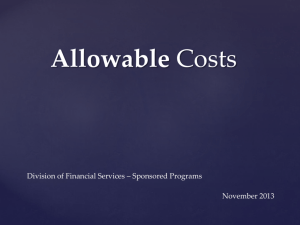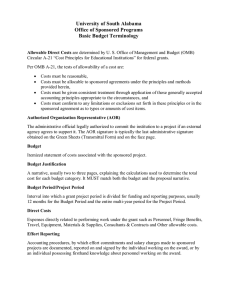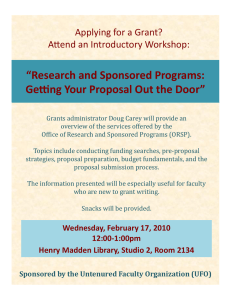/~orspwww/_researchadmin/_docs/directchargingexternalprocedure.doc
advertisement
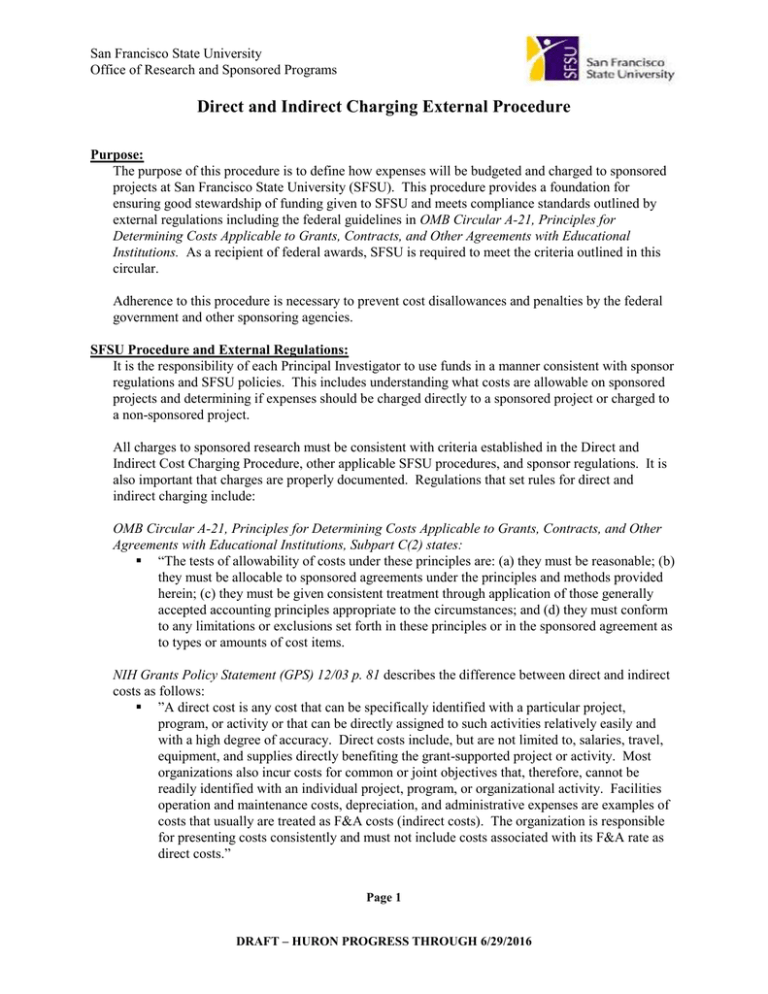
San Francisco State University Office of Research and Sponsored Programs Direct and Indirect Charging External Procedure Purpose: The purpose of this procedure is to define how expenses will be budgeted and charged to sponsored projects at San Francisco State University (SFSU). This procedure provides a foundation for ensuring good stewardship of funding given to SFSU and meets compliance standards outlined by external regulations including the federal guidelines in OMB Circular A-21, Principles for Determining Costs Applicable to Grants, Contracts, and Other Agreements with Educational Institutions. As a recipient of federal awards, SFSU is required to meet the criteria outlined in this circular. Adherence to this procedure is necessary to prevent cost disallowances and penalties by the federal government and other sponsoring agencies. SFSU Procedure and External Regulations: It is the responsibility of each Principal Investigator to use funds in a manner consistent with sponsor regulations and SFSU policies. This includes understanding what costs are allowable on sponsored projects and determining if expenses should be charged directly to a sponsored project or charged to a non-sponsored project. All charges to sponsored research must be consistent with criteria established in the Direct and Indirect Cost Charging Procedure, other applicable SFSU procedures, and sponsor regulations. It is also important that charges are properly documented. Regulations that set rules for direct and indirect charging include: OMB Circular A-21, Principles for Determining Costs Applicable to Grants, Contracts, and Other Agreements with Educational Institutions, Subpart C(2) states: “The tests of allowability of costs under these principles are: (a) they must be reasonable; (b) they must be allocable to sponsored agreements under the principles and methods provided herein; (c) they must be given consistent treatment through application of those generally accepted accounting principles appropriate to the circumstances; and (d) they must conform to any limitations or exclusions set forth in these principles or in the sponsored agreement as to types or amounts of cost items. NIH Grants Policy Statement (GPS) 12/03 p. 81 describes the difference between direct and indirect costs as follows: ”A direct cost is any cost that can be specifically identified with a particular project, program, or activity or that can be directly assigned to such activities relatively easily and with a high degree of accuracy. Direct costs include, but are not limited to, salaries, travel, equipment, and supplies directly benefiting the grant-supported project or activity. Most organizations also incur costs for common or joint objectives that, therefore, cannot be readily identified with an individual project, program, or organizational activity. Facilities operation and maintenance costs, depreciation, and administrative expenses are examples of costs that usually are treated as F&A costs (indirect costs). The organization is responsible for presenting costs consistently and must not include costs associated with its F&A rate as direct costs.” Page 1 DRAFT – HURON PROGRESS THROUGH 6/29/2016 San Francisco State University Office of Research and Sponsored Programs Direct and Indirect Charging External Procedure Lastly, all costs charged to a sponsored project must comply with any terms and conditions or restrictions of the Notice of Grant Award (NGA) or other award documentation. Examples include: i. Cost must be incurred during the defined budget period ii. Cost must be within the budget requirements/limits of the award iii. Equipment may not be purchased on this grant Procedure Details and Definitions: This section defines how this procedure applies to specific types of costs incurred at SFSU. It discusses the major factors that are taken into consideration in applying the procedure in these scenarios, subject to the restrictions and guidelines of the award sponsor. Definition of Sponsored Project: This procedure is specifically for defining how costs at SFSU should be charged to sponsored projects. These projects have been given to SFSU for a specific purpose and can only be spent in accordance with the wishes of the donor or sponsoring agency. For purposes of this procedure, SFSU defines a sponsored project as any grant, contract, or other agreement between SFSU and the federal government or other grantor agency. This does not include donations or gifts from individuals or corporations. Revenue and expenses for sponsored projects are tracked as separate cost centers. At SFSU, sponsored projects are assigned a project number in the PeopleSoft General Ledger between 10-69. This allows SFSU to appropriately manage unique requirements of different sponsors and monitor compliance with sponsor requirements. Direct Costs: Personnel: Salaries, Wages and Fringe Benefits: Salaries, wages, and fringe benefits for non-administrative personnel (such as PI’s, Coinvestigators, research staff, etc.) are allowable as direct charges on sponsored projects as long as the charges reflect the actual work performed and directly benefit the sponsored project. Where necessary, effort certification provides the documentation that SFSU uses to verify that the effort expended on projects matches the amount charged. For more information, please reference the Effort Certification Procedure (www.????). Salaries, wages, and fringe benefits for administrative personnel (such as department administrators) should typically not be charged directly to a sponsored project since these costs are reimbursed through the indirect cost rate (see the Indirect Costs section of this document). There are specific exceptions when these costs may be charged directly (see the Exceptions – Charging Indirect-type Cost as Direct Costs section of this procedure). Salary, wage, and fringe benefit charges must also be consistent with all other applicable SFSU procedures (e.g., Fringe Benefits, Earned Time, Leave of Absence, Vacation, etc.). Costs associated with providing fringe benefits to research personnel are charged on an actual basis to sponsored research projects. Page 2 DRAFT – HURON PROGRESS THROUGH 6/29/2016 San Francisco State University Office of Research and Sponsored Programs Direct and Indirect Charging External Procedure Examples of costs charged to capture fringe benefits include: FICA Health Insurance Pension and Benefits Earned Time Cash outs Employee Group Life & Disability Parking Subsidy Workers’ Compensation Insurance State Unemployment Tax Employee Tuition Reimbursements Day Care Subsidy Other (Fitcorp discount memberships, Employee Assistance Program, etc.) Human Resources – Benefits Office Independent Contractors (Consultants): Independent Contractors provide services to advance a specific portion of a sponsored project’s scope of work. Independent Contractors must be an individual of a profession and have a special skill that will contribute to the advancement of the research. The provider may be either a member of a profession or a person possessing a special skill; she or he cannot be on the SFSU payroll. Agencies vary in their requirements for approval of Independent Contractors. When Independent Contractor services are not in the awarded budget, refer to the sponsor guidelines for their specific requirements. Some agencies may require advance approval, but most agencies approve the use of Independent Contractors if the person(s) to be utilized provide expertise in the specific area of research, and the anticipated costs of their services are included in the awarded budget. However, even when this information is included in the awarded budget, the Independent Contractor must meet certain criteria. In determining the allowability of Independent Contractor costs, no single criteria or set of criteria is necessarily determinative. SFSU will use the following criteria: 1. Independent Contractors must be in good standing with the federal government i.e., not debarred from doing work. This can be determined by searching the Excluded Parties Listing System (http://www.epls.gov/) 2. The nature and scope of the service advance the project’s scope of work 3. The Independent Contractor is not an employee of SFSU or a SFSU affiliated foundation 4. If a Conflict of Interest exists with the individual providing the services, it is appropriately managed (any conflict of interest, should be disclosed by the principal and/or other investigator(s) on the Conflict of Interest Form and submitted to the Office of Research and Sponsored Programs). 5. Necessity of contracting for the service, considering SFSU resources in the particular area. 6. Reasonableness of costs in relation to customary fees charged, other Independant Contractors, sponsor guidelines, and industry standards. Page 3 DRAFT – HURON PROGRESS THROUGH 6/29/2016 San Francisco State University Office of Research and Sponsored Programs Direct and Indirect Charging External Procedure 7. Whether the service can be performed more economically by direct employment or otherwise. 8. The qualifications and credentials of the individual. 9. Adequacy of the contractual agreement for the service (e.g., description of the service, estimate of time required, rate of compensation, indemnification of SFSU and termination provisions). 10. The appropriate Accounts Payable forms are complete and supported with appropriate documentation. Independent Contractor costs must be reasonable, appropriately documented, and compliant with SFSU and sponsor guidelines. Certain sponsors, such as the National Science Foundation (NSF), limit Independent Contractor compensation. NSF limits Independent Contractor compensation to the amount of an Executive Schedule Level IV Federal employee (currently $537/daily), which is a good benchmark for other federal awards (NIH does not currently have a specific limit). Special Consultants: Special Consultants is a term used to categorize employees of SFSU that work or provide special services to sponsored research projects. Stipends and Tuition: Stipend and tuition costs are allowable direct charges to a project at the rate defined in the approved budget and within sponsor guidelines. For NIH training grants, stipend levels are published each year on the NIH website (http://grants1.nih.gov/training/nrsa.htm - inst). Other sponsors have similar limits for stipend levels. Any changes in stipend and/or tuition rates require sponsor approval. If the approved budget does not include stipends or tuition, most sponsors require prior approval. To be competitive and attract the best trainees, additional compensation may be provided to trainees. SFSU may choose to provide additional compensation above the maximum stipend paid by the sponsor if it is paid by the trainees’ department, or other funding source, and charged to a non-sponsored account. Equipment: SFSU defines capital equipment as items with an acquisition cost of $5,000 or more. Equipment that meets this definition and is used specifically for the benefit of the sponsored project may be charged directly to the sponsored project depending on the sponsor specific guidelines. This type of equipment is included as part of the cost reimbursed through the indirect cost rate (see the Indirect Costs section of this document). If an equipment purchase is specified in the awarded budget, further approval is generally not required. If the approved budget does not include equipment, most agencies require prior approval. For more information, please reference the agency guidelines and the SFSU Prior Approval Procedure (www.???). Page 4 DRAFT – HURON PROGRESS THROUGH 6/29/2016 San Francisco State University Office of Research and Sponsored Programs Direct and Indirect Charging External Procedure Supplies: Supplies directly related to the project, such as Technical or Scientific Supplies, are allowable if they are purchased to directly benefit the project. Other supply charges, such as Clerical and Office Supplies, are allowable underneath certain circumstances where they are necessary to complete the project and will not be used on another project. Clerical and Office Supplies are examples of charges that can be collected with the University’s F&A rate and are often unallowable (see F&A Rate section below). Travel: Travel costs, which include transportation, lodging, per diem, and incidentals, must meet the SFSU travel guidelines (http://www.foundation.sfsu.edu/content/view/28/66/). Any additional travel guidelines in the sponsored project award document must also be followed. Examples include: Receipts are required for all expenses greater than $25 Telecom will be reimbursed at actual expenditures with receipts. Travel costs (except for per diem and mileage) must be charged on an actual basis First class air fare is not reimbursable except in extraordinary circumstances and must be pre-approved by ORSP. Only US Flag Carriers can be used for air travel Travel expenses that meet these guidelines and are included in the award budget require no further approval and can be directly charged to a sponsored project. If travel costs exceed the budgeted amount or if travel was not included in the awarded budget, refer to the specific sponsor guidelines regarding the allowability of travel. Some sponsors require prior approval. Animal Care: Animal Care costs included in the awarded budget are allowable direct charges to a sponsored project as defined by the sponsor guidelines. When a sponsored research project includes Animal Care costs, it is important that the appropriate rates are used. The housing costs are typically a per diem charge that varies by species. If Animal Care costs exceed the budgeted amount or were not included in the awarded budget, refer to the sponsor guidelines regarding the allowability of these costs. Some sponsors require prior approval. The Office of Protection for Human and Animal Subjects, has a information specific to animal and human subjects listed at their website (http://www.sfsu.edu/~protocol/index.htm). Subcontracts (Consortium/Contractual Costs): Subcontract agreements specified in the awarded budget are allowable direct charges to a sponsored project. If a subcontract is not in the awarded budget, refer to the sponsor guidelines for their specific requirements. SFSU requires that subcontractors submit a budget page thru ORSP that details the amount of money they are requesting (this is also a requirement of most sponsors). Subcontracts must be approved by the sub institution’s ORSP (or similar office). Page 5 DRAFT – HURON PROGRESS THROUGH 6/29/2016 San Francisco State University Office of Research and Sponsored Programs Direct and Indirect Charging External Procedure Indirect Costs or Facilities and Administrative (F&A) Costs: OMB Circular A-21 Section E(1) defines Facilities and Administrative (F&A) costs as “F&A costs are those that are incurred for common or joint objectives and therefore cannot be identified readily and specifically with a particular sponsored project, an instructional activity, or any other institutional activity.” F&A Costs are commonly referred to as Indirect Costs. Examples of F&A costs include: Salaries, wages, and fringe benefits for clerical and administrative staff Office supplies (basic supplies) Subscriptions Library books Periodicals Memberships Office and general equipments (e.g., desks, chairs, computers) Photocopying Postage Repair and maintenance (e.g., equipment, remodeling) Telephone and internet (e.g., monthly bills, installation, maintenance) Utilities Proposal development costs See the Exceptions – Charging F&A-type Costs as Direct Costs section of this document for special circumstances where it is appropriate to charges these types of costs directly to a sponsored project. F&A costs at SFSU are charged to a grant by means of the F&A rate (see Facilities and Administrative Rate section of this document), therefore, charging an F&A cost as a direct cost would charge the Sponsor twice for the same expense. Exceptions - Charging F&A-type Costs as Direct Costs: There are times when it is allowable to charge costs directly to a grant that are normally considered F&A costs. Justification for these types of charges must be well documented by the person incurring the cost. Examples of circumstances where direct charging of costs normally considered F&A costs is appropriate include: Large, complex programs, such as research centers, institutes, and other sponsored agreements that entail assembling and managing teams of investigators. Projects that require extensive data collection, accumulation, analysis, and/or cataloging. Projects that require preparation and production of manuals, large reports, and books to meet the objectives of a specific sponsored project. Projects designated as off-campus and are charged the off-campus F&A Cost rate. For example, off-campus projects are allowed to have rent and utilities directly charged to them. Page 6 DRAFT – HURON PROGRESS THROUGH 6/29/2016 San Francisco State University Office of Research and Sponsored Programs Direct and Indirect Charging External Procedure Example Exception Expenses that Fall into this Category: Postage/Photocopies: These expenses are allowable direct charges to a sponsored project only if it can be documented that there is a direct benefit to the project (e.g., if survey is being conducted as part of a project, the photocopy and mailing expenses are allowable direct charges). Office Supplies: These expenses are allowable direct charges to a sponsored project only if it can be documented that there is a significantly greater amount required for a project (i.e, if a large number of Compact Discs need to be purchased to store data). Meetings and Conferences: Costs of meetings and conferences, whose primary purpose is the dissemination of technical information, can be charged to a sponsored project if it is specifically provided for in the awarded budget and it directly benefits the project. Sensitive cost items, such as flowers, party balloons, and gifts are not allowable or negotiable and should be charged to a non-ORSP discretionary project. Telecommunications: In general, only the telecommunications costs associated with a specific project can be charged directly to the relevant sponsored project (e.g., long distance charges can be direct charges to a sponsored project if the call was a direct benefit to the project). Records should document the appropriateness of these charges in all instances. If a telephone has been installed for the sole use of a particular grant or contract activity (e.g. if conducting a phone survey is an objective of the project) and it will be removed when the project terminates, monthly service, message service, and non-toll expenses can be charged to the sponsored project. Cell phones, pagers, personal digital assistants (e.g., Palm Pilots, etc.), and home Internet Service Provider charges are only allowable if explicit approval from the sponsor is received, programmatic necessity can be documented, and these services are used exclusively for the sponsored project(s). No other telecommunication expenses should be charged as direct costs to a sponsored project. Determining Allowable and Unallowable Costs: Allowable costs must meet the terms and conditions of the award and a test of reasonableness. It is the responsibility of each Principal Investigator to monitor the award budget and ensure that purchases are made in a timely manner. Purchases should take into consideration the time it will take SFSU to process a purchase requisition and create a Purchase Order, the time it will take for a vendor to process and ship an order and the amount of time it will take to consume the products purchased. Large purchases made towards end of a budget period (e.g., a large amount of general lab supplies are purchased during the last week of an award) where it is not reasonable to expect the products purchased can be used by the end date of the project are unallowable. Purchasing any item to “use up” available funds is prohibited by federal regulation. All costs charged to a project must specifically benefit the project they are charged. Page 7 DRAFT – HURON PROGRESS THROUGH 6/29/2016 San Francisco State University Office of Research and Sponsored Programs Direct and Indirect Charging External Procedure Certain costs are not allowable charges to a sponsored project, either directly or indirectly. SFSU reviews costs based on the guidelines in the Office of Management and Budget Circular A-21 (http://www.whitehouse.gov/omb/circulars/a021/a21_2004.html#j), examples include: Cost Items Selected Cost Items Applicable A-21 section Advertising and public relations costs Advisory councils Alcoholic beverages Alumni/ae activities Audit and related services Bad debts Bonding costs Commencement and convocation costs Communication costs Compensation for personal services Contingency provisions Deans of faculty and graduate schools Defense and prosecution of criminal and civil Proceedings, claims, appeals and patent infringement Depreciation and use allowances Donations and contributions Employee morale, health, and welfare costs Entertainment costs Equipment and other capital expenditures Fines and penalties Fund raising and investment costs Gains and losses on depreciable assets Unallowable with stipulations. A-21 J (1) Allowable with stipulations. A-21 J(2) Unallowable. A-21 J (3) Unallowable. A-21 J (4) Allowable with restrictions as addressed in OMB Circular A-133. . A-21 J (5) Unallowable. A-21 J (6) Allowable with stipulations. A-21 J (7) Unallowable except for provisions in A-21 F (9). A-21 J (8) Allowable. A-21 J (9) Allowable. A-21 J (10) Unallowable with stipulations. A-21 J (11) Allowable. A-21 J (12) Unallowable with stipulations. A-21 J (13) Allowable with stipulations. A-21 J (14) Unallowable. A-21 J (15) Allowable. A-21 J (16) Unallowable. A-21 J (17) Allowable with stipulations. A-21 J (18) Unallowable with stipulations. A-21 J (19) Unallowable with stipulations. A-21 J (20) Allowable with stipulations. A-21 J (21) Page 8 DRAFT – HURON PROGRESS THROUGH 6/29/2016 San Francisco State University Office of Research and Sponsored Programs Direct and Indirect Charging External Procedure Goods or services for personal use Housing and personal living expenses Unallowable. A-21 J (22) Unallowable. A-21 J (23) Unallowable with stipulations. A-21 J Idle facilities and idle capacity (24) Allowable with stipulations. A-21 J Insurance and indemnification (25) Allowable with stipulations. A-21 J Interest (26) Labor relations costs Allowable. A-21 J (27) Unallowable with stipulations. A-21 J Lobbying (28) Losses on other sponsored agreements or contracts Unallowable. A-21 J (29) Maintenance and repair costs Allowable. A-21 J (30) Material and supplies costs Allowable. A-21 J (31) Meetings and conferences Allowable. A-21 J (32) Allowable with stipulations. A-21 J Memberships, subscriptions and professional activity costs (33) Allowable with stipulations. A-21 J Patent costs (34) Plant and homeland security costs Allowable. A-21 J (35) Unallowable with stipulations. A-21 J Pre-agreement costs (36) Professional service costs Allowable. A-21 J (37) Unallowable, possibly captured in Proposal costs F&A Cost. A-21 J (38) Unallowable with stipulations. Possibly captured in F&A Cost. A-21 Publication and printing costs J (39) Rearrangement and alteration costs Allowable. A-21 J (40) Reconversion costs Allowable. A-21 J (41) Allowable with stipulations. A-21 J Recruiting costs (42) Allowable with stipulations. A-21 J Rental costs of buildings and equipment (43) Allowable with stipulations. A-21 J Royalties and other costs for use of patents (44) Allowable with stipulations. A-21 J Scholarships and student aid costs (45) Unallowable with stipulations. A-21 J Selling and marketing (46) Specialized service facilities Allowable. A-21 J (47) Student activity costs Unallowable with stipulations. A-21 J Page 9 DRAFT – HURON PROGRESS THROUGH 6/29/2016 San Francisco State University Office of Research and Sponsored Programs Direct and Indirect Charging External Procedure Taxes Termination costs applicable to sponsored agreements Training costs Transportation costs Travel costs Trustees (48) Allowable. A-21 J (49) Allowable with stipulations. A-21 J (50) Allowable. A-21 J (51) Allowable. A-21 J (52) Allowable with stipulations. A-21 J (53) Allowable. A-21 J (54) Unacceptable Direct Charging Practices: The following practices are inappropriate for charging direct costs to a sponsored project: Shifting costs to other sponsored projects in order to meet budget or funding deficiencies. Shifting costs to other sponsored projects to avoid sponsor restrictions. Assigning costs to projects based on remaining balance, such as: - Assigning large equipment expenditures at the end of a project. - Increasing salary expenses on a project with an available balance when it is not consistent with the actual effort expended. Charging costs incurred for multiple projects or functions to several sponsored projects when there is difficulty determining the relative benefit of the cost to each sponsored project (see Charging Costs to Multiple Projects below). Charging an expense exclusively to one award when the expense was used to support other activities (see Charging Costs to Multiple Projects below). Rotating charges among projects without establishing that the rotation schedule accurately reflects the relative benefit to each project during that specified period. Charging the budgeted amount (in contrast to charging an amount based on actual costs). Assigning charges to an award before the cost is incurred (with the exception of deposits). Assigning charges that are part of the normal administrative support for awards (e.g. proposal preparation, accounting, payroll). Charging Cost to Multiple Projects: Some direct costs benefit multiple projects (e.g., copying publishing costs, bulk lab supplies, office supplies). These costs should be allocated to projects in proportion to the benefit. The NIH Grants Prolicy Statement says: “When salaries or other activities are supported by two or more sources, issues arise as to how the direct costs should be allocated among the sources of support. In general, a cost that benefits two or more projects or activities in proportions that can be determined without undue effort or cost should be allocated to the projects based on the proportional benefit. A cost that benefits two or more projects or activities in proportions that cannot be determined because of the interrelationship of the work involved may be allocated or transferred to the benefiting projects on any reasonable basis.” Page 10 DRAFT – HURON PROGRESS THROUGH 6/29/2016 San Francisco State University Office of Research and Sponsored Programs Direct and Indirect Charging External Procedure As long as the costs charged are allowable, allocable, and reasonable under the applicable cost principles and the grantee’s financial management system includes adequate internal controls (for example, no one person has complete control over all aspects of a financial transaction), a grantee may allocate costs normally assignable to multiple projects to one of those projects. The method for allocating direct costs to multiple projects must be identified in advance of the allocation and documented so a person unfamiliar with research administration would understand. Documentation to split costs for purchase requisitions should be included in departmental records. Documentation for allocation of special check requests through accounts payable should be documented in the comments sections of the request. The allocation method must be consistently applied to all sponsored projects in a defined group (e.g., department, PI, etc.). Switching between methods for convenience is not acceptable. Some reasonable methods to allocate costs to multiple projects include allocating costs based on: Number of lab personnel working on each project Number of activities performed, e.g. project A has 20 experiments and project B has 40 experiments therefore 1/3 of the costs will be allocated to project A and 2/3 of the costs will be allocated to project B Rates established by service center or other lab that highly correlates with the cost being allocated, e.g. animal facility charges An inventory tracking sheet Cost methods that should NOT be used to allocate costs to multiple projects include allocating costs based on: Budget amount Remaining unspent funds Rotating costs between projects Square footage Indirect Costs or Facilities and Administrative (F&A) Rate: It is SFSU’s procedure to not “waive” (i.e. charge a lower amount than the federally negotiated rate) F&A except when required by sponsor procedure. F&A costs are paid to SFSU as a percent of direct expenditures. Approximately every four years, SFSU negotiates an F&A cost agreement with their cognizant government agency (Department of Health and Human Services). The SFSU F&A cost rate (http://www.sfsu.edu/~orspwww/_postaward/_grantspolicies/sfsu_idcagreement.pdf ) states the amount of F&A costs in a percent that the government will reimburse to SFSU. Federal: The percent listed on the SFSU F&A cost rate (see above) should be used except for programs that publish a lower rate such as training grants, career awards, certain RFP’s or RFA’s, etc. Depending on where the research is taking place (on campus or off campus) or what type of research (basic research or other sponsored activities) different rates will apply. Page 11 DRAFT – HURON PROGRESS THROUGH 6/29/2016 San Francisco State University Office of Research and Sponsored Programs Direct and Indirect Charging External Procedure Non-Federal: Many non-federal sponsors, such as foundations, limit the F&A amount that they will pay. In these cases, SFSU will charge the maximum amount allowed by the sponsor. Subcontracts: It is important to determine the original source of funding on any “sub-in” or “sub-out” agreement. It may be federal (federal “pass-thru”) or non-federal. Based on this determination, the appropriate criteria listed above should be used to determine the F&A rate. Procedure: The Direct and Indirect Cost Charging Procedure outlines how sponsored research expenses should be budgeted and charged to Projects at SFSU. This procedure allows SFSU to meet external regulations and treat costs consistently across the institution. PIs and department administrators should use this procedure as a guideline for budgeting and charging direct and F&A costs to sponsored research. PIs and department administrators are responsible for understanding this procedure, other SFSU procedures, and external regulations when determining if costs should be directly charged to a project or charged to the appropriate department account. All questions should be directed to ORSP personnel. The Office of Research and Sponsored Programs (ORSP) reviews proposal budgets before they are submitted to sponsors for compliance with SFSU and sponsor guidelines. When assigning research costs to a project, PIs and departments are responsible for using the appropriate PeopleSoft project numbers and accounts. They are also responsible for retaining documentation for transactions including justification for costs not typically considered direct costs. This documentation should include an explicit explanation as to how the cost benefited the sponsored project and when applicable, an explanation of how the cost was allocated between multiple projects. ORSP’s Post Award Office reviews selected costs on a periodic basis that are directly charged to sponsored projects to monitor consistency with external regulations and SFSU procedures. If it is determined that a cost is not consistent, ORSP is responsible for contacting the PI and ensuring that the cost is not charged to the sponsor. Roles and Responsibilities: Principal Investigators (PIs) and department administrators: PIs and department administrators are responsible for understanding sponsor and SFSU guidelines and to ensure that costs are appropriately and consistently budgeted and applied to sponsored projects. PIs and department administrators are responsible for documenting transactions in compliance with this procedure. Office of Research and Sponsored Programs (ORSP): ORSP completes a review of proposal budgets for compliance with this procedure, other SFSU procedures, and sponsor requirements. ORSP is also a resource for PIs and department administrators in providing clarification (when needed) for how costs should be budgeted for sponsored projects. Page 12 DRAFT – HURON PROGRESS THROUGH 6/29/2016 San Francisco State University Office of Research and Sponsored Programs Direct and Indirect Charging External Procedure ORSP Post Award Office: The Post Award Office reviews costs that are directly charged to a sponsored project for consistency with sponsor and SFSU guidelines. The Post Award Office is also a resource for PIs and department administrators in providing clarification (when needed) for how costs should be charged to sponsored projects. Related Policies and Procedures: Prior Approval Procedure: www.???? Cost Transfer Procedure: www.???? Forms and Links: Office of Management and Budget Circular A-21 http://www.whitehouse.gov/omb/circulars/a021/a21_2004.html#j NIH Grants Policy Statement http://grants.nih.gov/grants/policy/nihgps_2003/index.htm OMB Circular A-122 (Cost Principles for Non-Profit Organizations) http://www.whitehouse.gov/omb/circulars/a122/a122_2004.pdf Page 13 DRAFT – HURON PROGRESS THROUGH 6/29/2016

